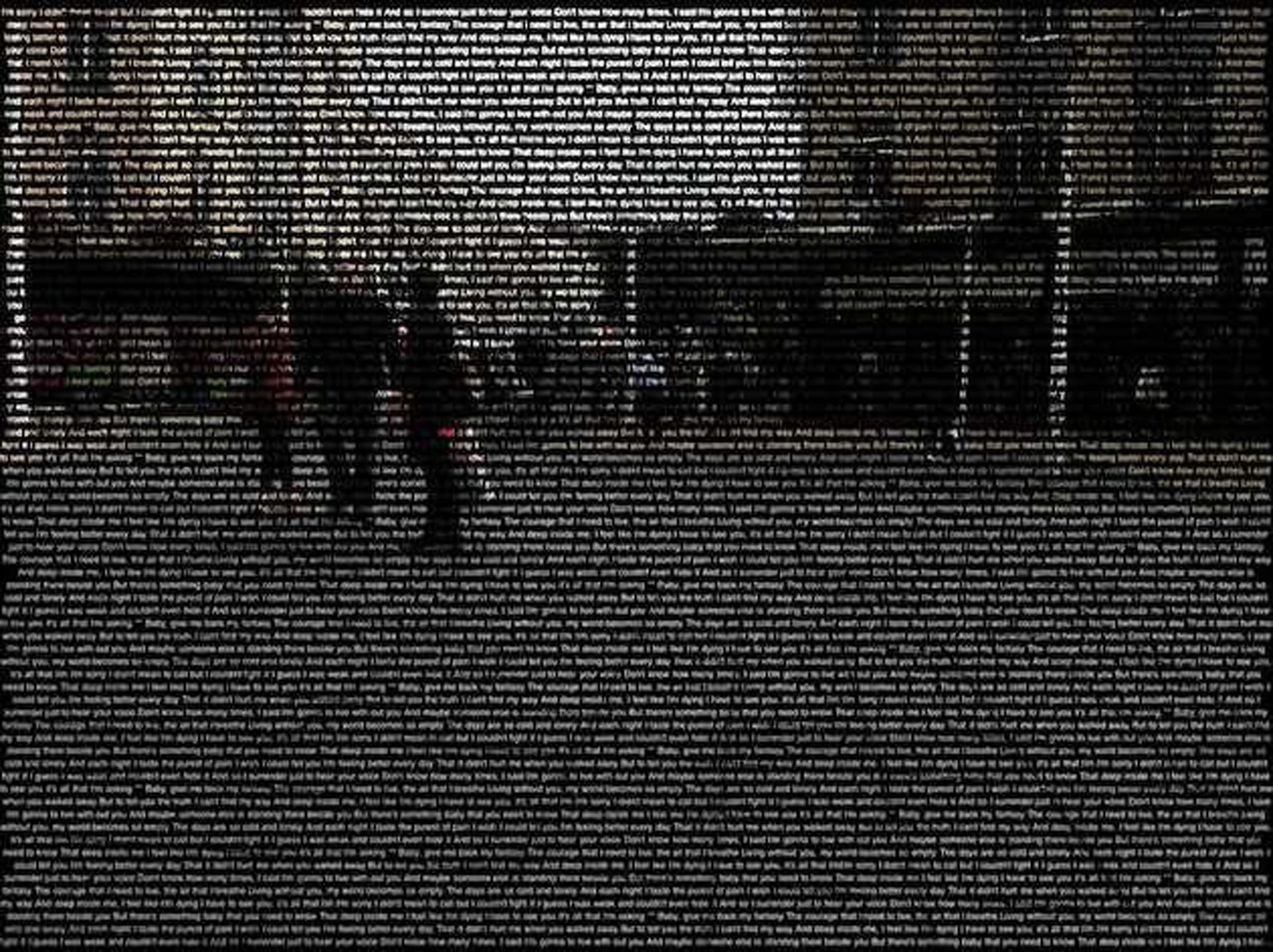The modern explorer has it all. Every gadget you can think of combined into a pocket-sized smartphone. There’s no need to be lost, or lonely, anywhere. Ever. Unless we explore with our eyes closed, figuratively speaking.
I like that idea, though. Exploring with my eyes closed. I want to try it. For help, I’ve turned to a man called Alan Godfrey, an unsung hero of modern England. Mr. Godfrey owns a small publishing company.
From an office in the little town of Consett in the northeast, Mr. Godfrey republishes old maps of towns and villages of England. These maps are sold at the bargain price of £2.50 each, so cheap you can subscribe to have them delivered to you every month, probably for less than the price of a newspaper. Armed with one, you can reexamine your surroundings to see what remains and what has gone. You can read the fascinating notes Mr. Godfrey or his associates have written on the reverse. You can explore time and space simultaneously, for less than the price of a pint of English beer, then fold up space-time and put it in your pocket.
I am in Bristol, England’s sixth largest city. In my hands I hold a selection of Godfrey’s marvelous maps, dated 1901. Whole chunks of the 1901 city have gone, destroyed by war and progress. But larger chunks of undisturbed history remain.
My plan is to roam with my maps and a smartphone, noticing as much as I can. I’m going to notice the hell out of things. I’m going to immerse myself in the detail of the city, and attempt to mirror Godfrey’s historical details with modern data-details of my own.
11:15 a.m.
This is the center of Bristol. It is 19 degrees centigrade. There are no buses here. There are no bikes here. I can see eight strollers, and many shops. Battery level on my iPhone is 87 percent. My phone is loaded with extra apps today, for the purposes of data collection—to record my route, measure the environment, and capture the scenery.
There are no bikes here. There are no strollers here. It is 18 degrees centigrade. The wind feels chilly. I can smell concrete.
The weather is dry but overcast. Warmish, for England, at this time of year. A bit sticky. I can smell disinfectant. The ambient noise level is 70 dB—I have an app that says so.
In 1901, this was the point where two tram lines met, or perhaps diverged. One headed north-northwest up what used to be called Old King Street and is now called Merchant Street. It ploughed through the department store now blocking one end of the road and went northwards into the suburbs. The other line headed west-southwest along what was then called Broadmead and is still called Broadmead.
In 1901, Broadmead was lined with narrow buildings extending away from it at right angles. There were shops, yes, but other buildings too—a meat market, a sawmill, a chapel. Few of them remain. Now, this whole district is built for praying to money: there are phone shops and clothes shops and department stores here.
Video captured by Real World ASCII for iOS.
11:21 a.m.
I walk along Broadmead. There are two men eating sandwiches. I photograph them, but they disregard me.
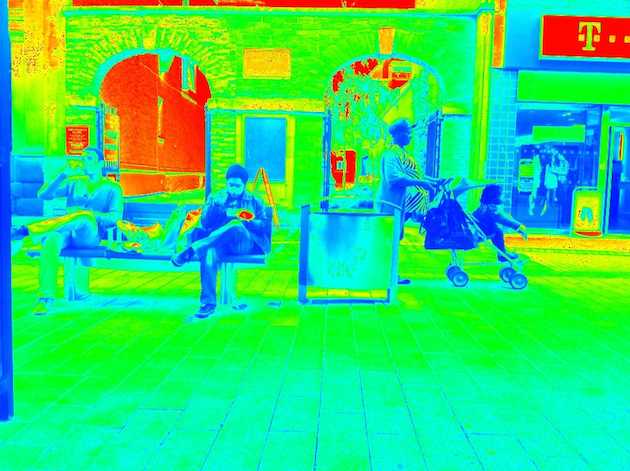
11:25 a.m.
I am at the junction of Broadmead and Union Street. There are two bikes. There are two strollers. I see a bearded man in pinstripes and a pale cream summer jacket. His beard is spectacular. He disregards me. The noise level is 72 dB.
I cross Union Street and walk along Nelson Street.
11:28 a.m.
There are two strollers. The noise level is 72 dB when no bus is passing, and 82 dB when a bus is passing. Many buses pass.
11:30 a.m.
There is an old police station building on my right. In 1901, the police station was one block further north. It shared premises with the fire department. There was a large courtyard in the center of the building. The newer police station is now a temporary art exhibition space, pending future redevelopment. I can smell diesel.
11:33 a.m.
I am walking south-southwest along Fairfax Street, a modern replacement for Duck Lane, which followed roughly the same path in 1901. The 1960s hated this street and stripped it of whatever soul it might once have had. There is a car parts shop here where I think there used to be a school—but it’s hard to be sure, because the print on the old map is tiny, and the breeze keeps folding the map up in front of my eyes. At the other end, several floors up in a many-windowed building, there is a gym. An attractive woman runs on a running machine in one of the windows, as if she’s advertising the gym’s services. She disregards me.
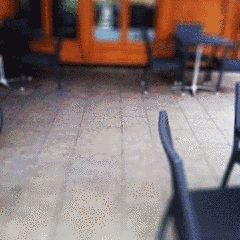
Turn back on myself, returning to Nelson Street via All Saints’. Then immediately left into a tiny alleyway, one of those alleyways you only turn into because you feel the urge to walk somewhere you haven’t walked before. This is a personal policy of mine; as often as possible, I take new routes, walk paths I’ve not walked.
11:36 a.m.
John Street, today and in 1901. Even in 1901, the graveyard on one side was disused. It remains so, a tiny patch of grass with a handful of forgotten graves and a single large tree. The noise level is 65 dB. The street is appropriately, respectfully, quiet. Left into Broad Street. An electric vehicle passes me—this is the only one I’ll see today.
11:39 a.m.
A woman is working hard, bent over a sewing machine in a shop window, as if she’s a performing mannequin. She disregards me.
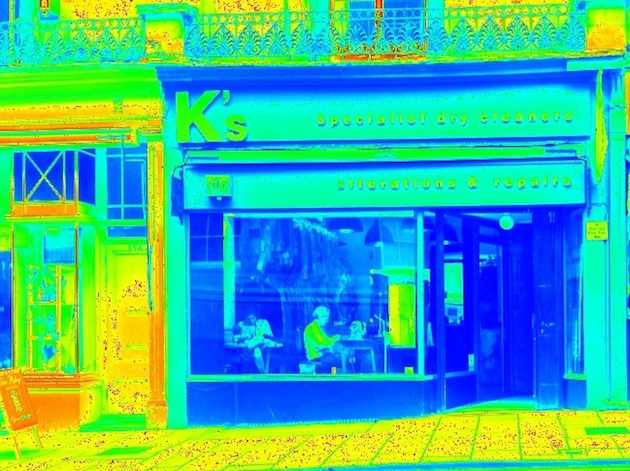
11:40 a.m.
I am outside the city’s Register Office, where civil marriages are conducted. This has been a public building for a long time; in 1901, it was called the “Council House.” The crossroads here was once the center of Bristol, Alan Godfrey tells me in his notes. A stone cross stood here, at the spot where retail trucks park to unload. Now it’s just another junction. The wider city disregards it.
A man is wearing amazing boots, dark leather with furry tufts. He is either incredibly cool or slightly ridiculous, depending how old you are as you observe him. I am at the slightly ridiculous end of the scale, and that is because I am 40.
Battery level is 76 percent. The temperature is 18 degrees centigrade. A marriage is taking place at the Register Office today. The bride and groom emerge with a very small entourage. The bride is tiny. Like a character from Harry Potter producing a wand from a fold in her robes, she produces a cell phone from a fold in her white figure-hugging, breast-enhancing gown, and chats as her husband, towering over her, meekly waits while family members take photos. He grins because he is happy. There are no buses here.
The bride puts her phone away and suddenly slips on the steps. There is a collective “oooh” from all the onlookers as the bride bounces off her ass. “I’m fine, I’m fine,” she laughs. The noise level is 71 dB. Hubby pulls her back up again.
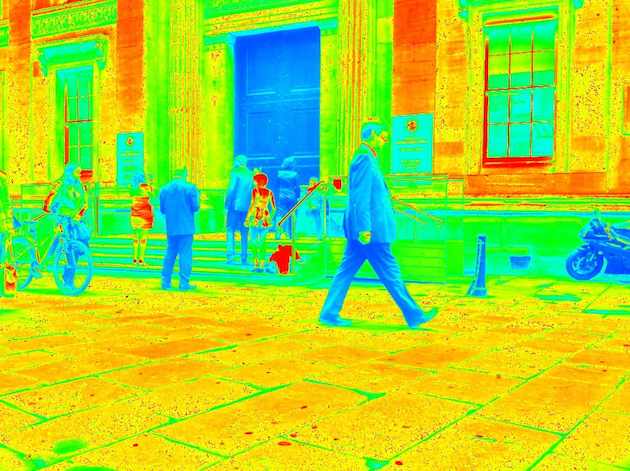
11:50 a.m.
I sit outside a café opposite the Register Office. I accidentally make eye contact with a good-looking girl as she walks by. She pushes her red hair behind one ear and looks away. In all other respects, she disregards me. She was probably disregarding me anyway.
11:53 a.m.
I resume walking, southwesterly, along Corn Street. In 1901 it was lined with large banks. They’re all restaurants and bars now. Late on Saturday nights, this street hums with people out to get pissed and go clubbing. Right now it feels quiet. There are no buses. There are no bikes. There are no strollers. There are people in suits.
12:00 p.m.
Turn left into St. Nicholas Market. It’s now a covered square full of stalls selling knickknacks and thingummyjigs. In 1901, this was the Corn Exchange, the building that gave its name to Corn Street.
Video captured by Real World ASCII for iOS.
There is the smell of curry. The smell of koftas. A man with a loud voice compares cigarettes to hamsters.
Behind the old Corn Exchange is another, elongated, covered market, one of Bristol’s hidden gems. Once it would have been a daily market selling fresh produce. Now the stalls flog fast food to office workers during their lunch breaks. The air is thick with food smells here.
12:10 p.m.
The Floating Harbour, or at least one end of it. In 1901 there was a strip of parkland in the center of Colston Avenue, an area now thick with traffic and tarmac. There are five buses here. Eight. Nine. It is 19 degrees centigrade. An elderly woman walks by wearing bright pink lipstick and a matching pink shirt. There is no harbor here, but there are fountains. Some of them run red. I don’t know why.
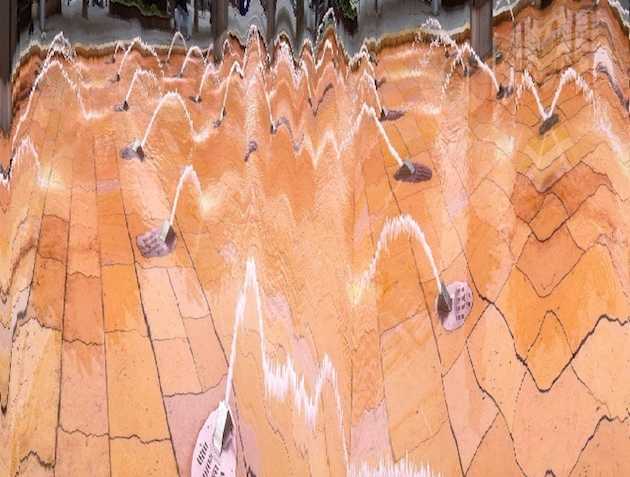
12:19 p.m.
Standing in a busy road, I can overlay history thanks to an image from HistoryPin. In olden days, people took photos on their iPhones for future use in this manner. For a moment, I can see what my old map depicts.
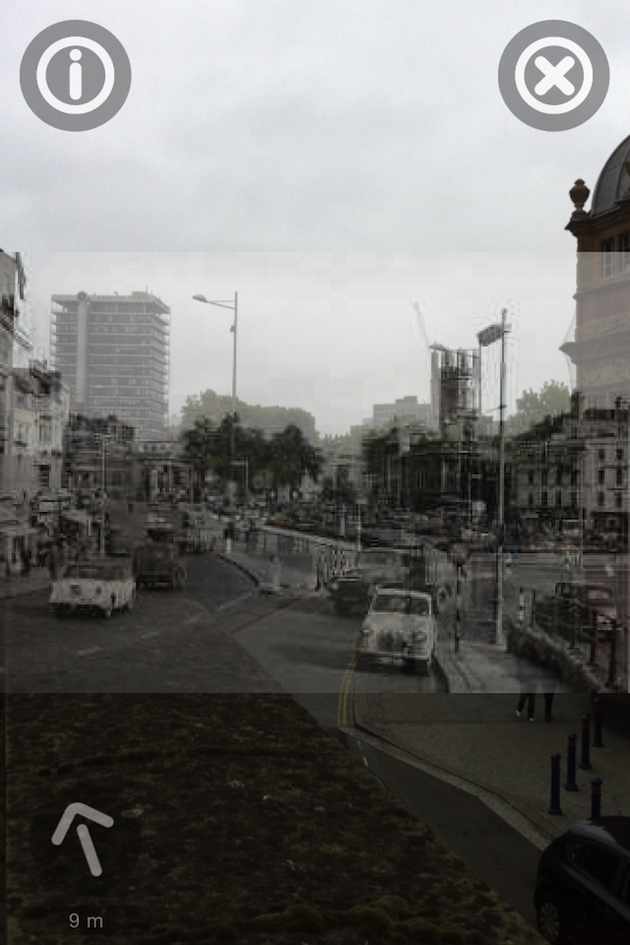
The noise level is 84 dB.
12:20 p.m.
There are no other pedestrians in this quiet back street. In 1901, these riverside warehouses buzzed with trade. This street thronged with carts and horses and workers. There are no bikes here. There are no strollers here. It is 18 degrees centigrade. The wind feels chilly. I can smell concrete.
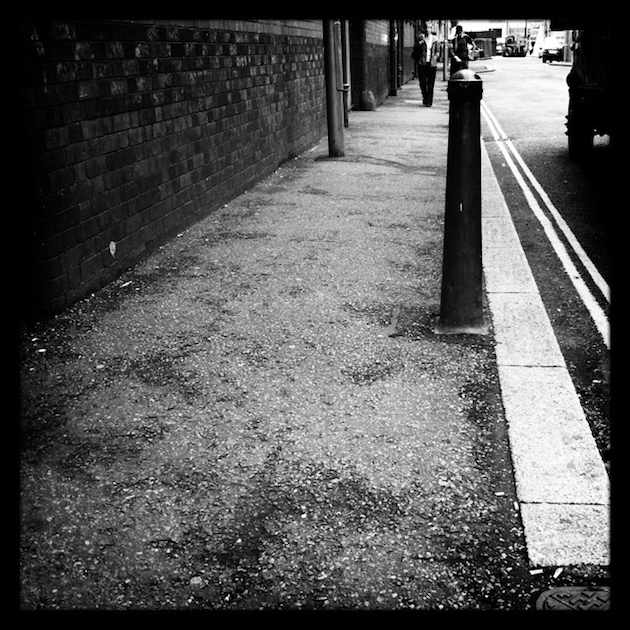
12:25 p.m.
The warehouses are trendy bars and trendier arts spaces now. A cinema on this side of the water, a gallery and architecture bookshop on the other. A man walks past a place called Zaza, and disregards me.
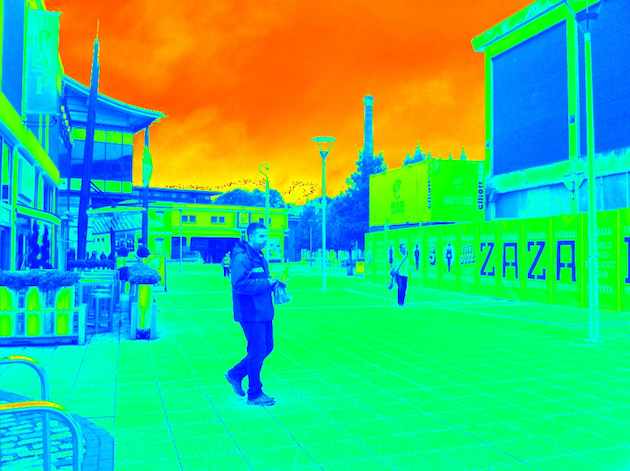
Another man is wearing amazing boots, dark leather with furry tufts poking out around the tops. He is either incredibly cool or slightly ridiculous, depending how old you are as you observe him. I am at the slightly ridiculous end of the scale, and that is because I am 40. The noise level is 64 dB.
12:50 p.m.
A place called Canon’s Marsh. It is a huge concrete public square. There is no marsh here. In 1901, this was a timber yard with a sawmill, a slate works, and a marble factory. Cranes lined the harborside, ready to load and unload transatlantic trade vessels that moored up here. There was the smell of fresh-cut wood and tobacco. Opposite, huge warehouse buildings stored grain.
In 2011, the huge warehouses are museums. We shall end our journey outside one of them soon. The timber yard is this plaza, now decorated with a unique water feature. Despite signs warning people not to play in the water, this place throngs with wet children on any warm sunny day when there’s no school. Today the throng is office workers and shadows.
Video captured by Real World ASCII for iOS.
In summer, the city hosts festivals and the square becomes a music venue, theater, and circus tent. One such festival has just ended, or is just being set up: it’s hard to tell which. A line of portable plastic toilets stinks its way along a path. Merge our timelines, and these plastic pissing boxes cut right through the sawmill’s teeth.
There is a man in a business jacket with a Mohican haircut. There are two joggers. There is one helicopter.
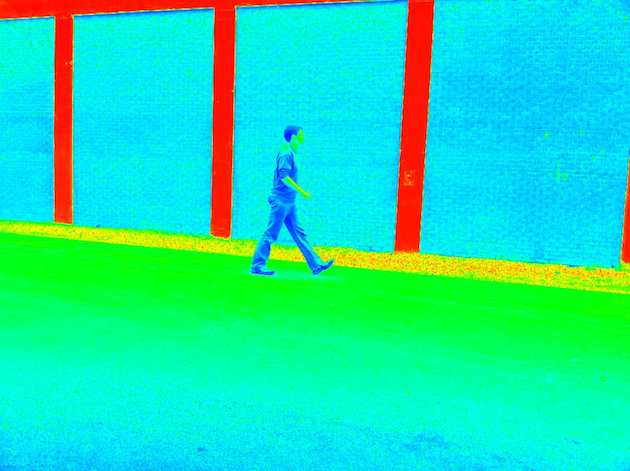
A woman gains access to a building with an ID card on a lanyard around her neck. A woman in high heels tells a man about the time she ran out of petrol.
There are two more joggers. There is one bike. There is one seagull.
12:51 p.m.
Heading due east again, back towards the old harbor and the pedestrian bridge that crosses it. The bridge is named after a slave called Pero. In 1901 this bridge wasn’t here, but there was a tiny ferry connection from one side of the harbor to the other. That foot traffic has never slowed. On the bridge there are men in yellow high-vis jackets. There is one jogger. There is one stroller. There is one fashion victim in his late 40s, wearing expensive trainers and a Tintin quiff that makes me inwardly remark: “OMG.”
Video captured by Real World ASCII for iOS.
There are two more strollers, one being pushed by a jogger. Double points. My tally so far stands at fifteen strollers, nine confirmed buses (but probably more), five joggers and three bikes. I have been walking for 96 minutes. I am thirsty. I can smell shoes.
12:56 p.m.
There is a busker here, tuning his ukelele.
A man holding an old-fashioned cassette Walkman sits on a bench, telling another man tales of gigs he’s been to. The listener seems disinterested. The two men disregard me.
1:01 p.m.
This is Narrow Quay. There were cranes here in 1901. It is 19 degrees centigrade. The noise level is 68 dB. Battery level is 44 percent. There are two bikes. There is one jogger. There are no buses. Two girls take photographs of each other. A gang of youths loiters. A man sits alone by the water’s edge. I take a photo of him from behind, and his behind disregards me.
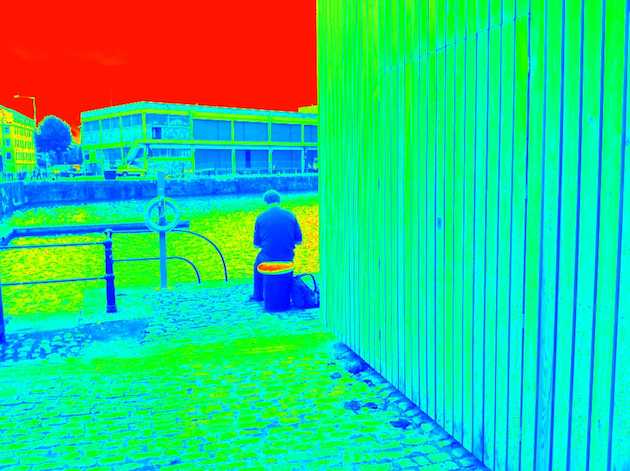
I walk to Prince Street swing bridge. My timelines merge right here, on this bridge. It swung in 1901 and it swings today. It loved me then, just as it loves me now.
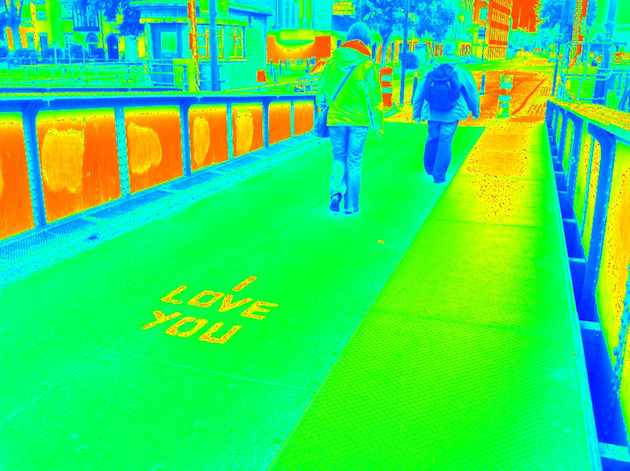
Here, on the bridge, you can see history leaking through into the present. The sounds of water lapping against the bridge’s footings below, the sounds of boats and boatmen. A century of trade and war and progress and demolition and rebuilding and trams and buses and all of it passes by within sight of where I’m standing. There is a jogger here. Ahead of me in 1901, there was a public urinal, but it’s part of the street now.
I record video of the timelines as I see them:
1:14 p.m.
I have burned 269 calories.
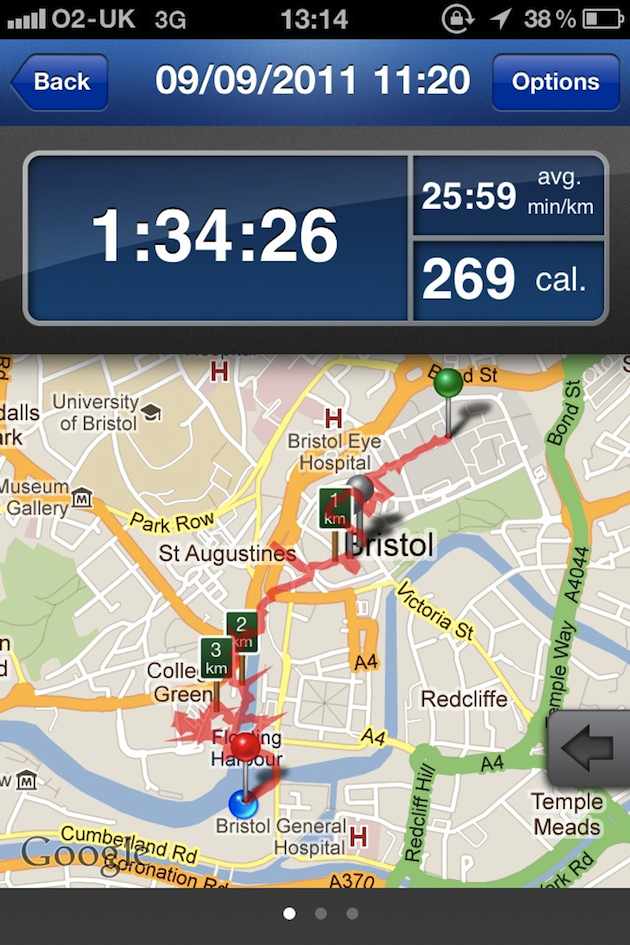
Outside the museum that used to be a warehouse, I look back at where I have been. There is a strong smell of diesel here. There are strollers here, the air is at a certain temperature, and my brain registers noises at a variety of levels. My phone’s battery is running low, but I think I might just disregard this.
There is a fine city before me. It glints when the sun emerges from behind gray English late summer clouds. Its past self can be glimpsed between the office buildings and the cell phone masts. It can be seen in the bricks, the pavements and the bridges, old and new.
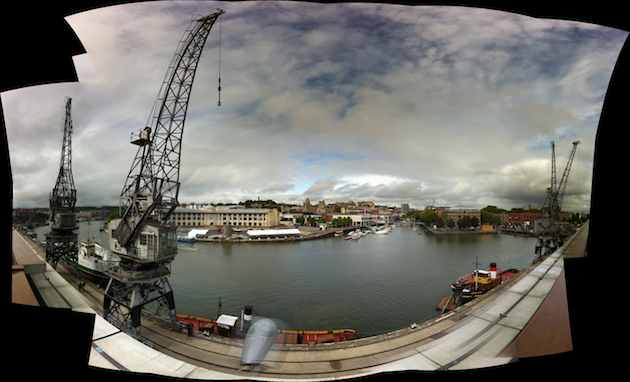
I fold my map, cast a look to the northeast, and send silent thanks to Alan Godfrey in his office in Consett, where they make time machines for £2.50.
There are four joggers here. One is lagging behind.
